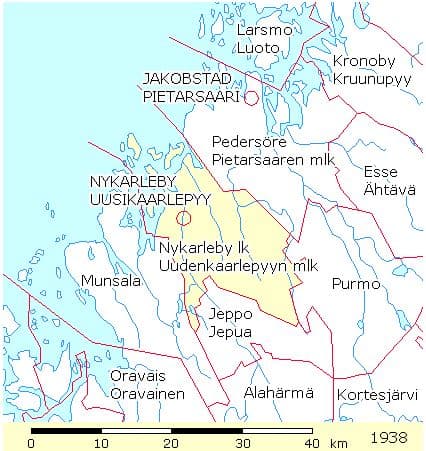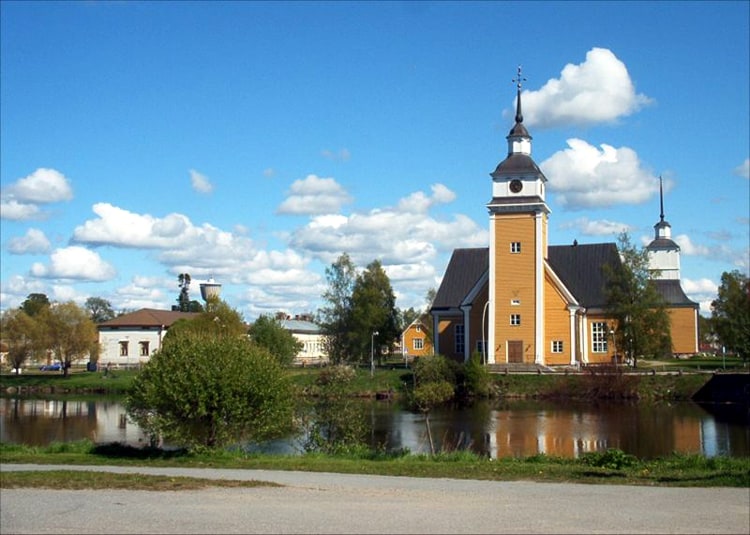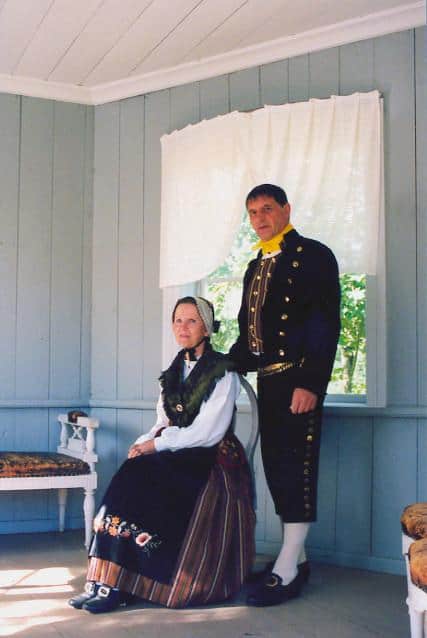Ostrobothnia
Nykarleby
Land & Livelihood
”Homes and fields were positioned near rivers. Among the fields and between the forests were meadows. The meadows typically included birch and alder trees, intentionally left to shade the ground and keep it wet. Their leaves also fertilized the meadows. Fields and meadows were fenced off from the forest. In the summertime cattle grazed in the forest and were kept out of the meadows. After fields and meadows were harvested, the cows were let in. Cows gave milk only in the summertime. From the milk, butter was made. In the fall, the cattle which they could not feed over the winter were slaughtered.
Many small farmers raised around six to ten acres of barley or rye, which usually wasn’t enough for each homestead and they would need to purchase more. They also grew turnips. Corn was grown, but only for feed for cattle.
Livestock was limited to cows and sheep. Horses were used for work and transportation. The number of animals were limited by access to cattle food for the winter. Feed was from the meadows and sea, lakeshores, marshes, and wherever they could find something. They also uses leafy branches and straw.

Fishing was almost as important as farming. The shoreline, creeks and rivers were rich with fish. The best fishing was in the spring as the fish spawn. Also in the spring tons of herring were caught.
As far as hunting, the seal catch was the only thing of importance. In March groups of eight to ten men went out on the ice of the Gulf of Bothnia. Before they had firearms, they hunted with harpoons. From the seals they would use the lard, which they boiled to create seal oil. This oil was often cold as lamp oil all over Europe. Meat and skins were also used. Seal hunting usually was over by the beginning of June. Squirrels were hunted for their gray fur, which were exported.
The wood became more valuable towards the end pf the sixteenth century when the forests in Europe began to diminish. Sawmills were built.
But more importantly was the production of tar. Tar was produced using young growing pine tree. Trees were barked on a line from ground to five yards up. That was repeated once a year for several years until all of the bark was gone. By doing this, the pines produced plenty of resin to protect themselves. One year after the last barking, the pines were cut and brought to a place with a tar pit where a stack was built. The pine wood was covered airtight and burned with little air and the resin was converted into tar. The tar ran out a pipeline from the bottom of the pit. Tar was exported to Sweden and all over the world.” 6
In the 1900’s Nykarleby switched from an agricultural town to becoming more industrial and service focused. 4
Nykarleby City History
Nykarleby is both a parish and a city. The parish was established before the city. In 1618 Filip Scheding, a chieftan for Gustof II Adolf was “sent to Osterbothnia to ‘investigate and view the posts, mostly visited by landscaping’ to determine which areas could become cities. Because there was a long way between the established cities of Oulu and Vaasa, the King was about to build a new city in Pedersöre. However, after studying the local conditions, Scheding decided to place the city in the Nykarleby parish instead of Pedersöre. ”
So, it was Scheding who appointed Leppo town to become a city. Once the appointment occurred, the farmers could apply for city privileges. The farmers were reluctant and didn’t act on their behalf to become a city. Two years later, in 1620, the small village of Lepua was chartered as a city. The Swedish name is Nykarleby, which means ‘New Karleby’. It was the next year that houses began to be built. 2, 7 The city began to flourish in the late 1700’s. 4 Nykarleby was chartered in the same year as the nearby city of Gamlakarleby (later called Karleby).
Parish History
- Nykarleby initially was a part of the Pedersöre parish 8
- The Nykarleby parish was formed in 1607 by connecting parts of the Pedersöre and Vöra parishes with Leppo town (Nykarleby City) at the mouth of the Lapuo River. 2, 4
Parish Records
Villages and farms of Nykarleby were recorded in T.W. Karsten’s work, Svesk Bygd I Osterbotten: Nu Och Fordom. 5 Nykarleby Parish Communion records were not used to confirm these findings. Because parish Communion records are listed by village and farm names and because farm names often were used as a part of a person’s name, it is interesting to note the following farms.
To open a printable list of villages and farms (pdf), click here.
Villages & Farms
The historic villages of Nykarleby parish include:
- Kyrkobyn – the church village
- Forsby
- Kovjoki
- Markby
- Soklot
- Ytter-Jeppo
- Juta
- Klockars
- Ols
- Isakas
- Forsbacka
- Jutbacka
- Nybacka
- Smedsbacka
- Högbacka
- Kuddnäs
- Frill
- Nygård
- Jeansborg
- Bonäs
- Drakabacka
- Bro
- Mickelsbacka
- Yrjäs
- Pelkos
- Bäck
- Lillollas
- Renvaktar
- Kärr
- Harald
- Sorvist
- Hannula
- Lassila
- Runt
- Petas
- Biggas
- Lukas
- Nygård
- Långholm
- Finne
- Marken
- Gästgivars
- Sigfrids
- Snåre
- Vik
- Tågs
- Nybonde
- Ainäs
- Mannfors
- Harald
- Mikkilä
- Nisula
- Nors
- Björn
- Hemming
- Nikonen
- Rank
- Hints
- Frost
- Gertruds
- Smeds
- Knuts
- Bro
- Ryss
- Back
- Lågväg
- Högväg
- Knock
- Järpe
- Draka
- Lävälä
- Löv
- Bjons
- Dalabacka
- Lillas
- Runt

release this work into the public domain. This applies worldwide. Attributed to User: Bbx
Of Interest
The battle of Jutus
The Finnish War was fought by the Kingdom of Sweden and the Russian Empire from February 1808 to September 1809. It was during the Finnish War that the battle of Jutus was fought, only four kilometers south of Nykarleby’s city’s center. 1, 4 7 As a result of this war, the eastern third of Sweden was established as the autonomous Grand Duchy of Finland within the Russian Empire.
Nykarleby railroad
In 1899, the Nykarleby railroad opened connecting Kovjoki to Nykarelby town and its strategic harbor. Unfortunately the railroad was in use for only about 17 years. At the onset of WWI, many Finnish railways were obliged to give free transportation to the Russian military and the Russians also confiscated many railways for their own use. Once the rumor spread that the Russians would appropriate the Nykarleby railway, a quick decision was made to sell it. In 1916 the deal was finalized and the railway was closed and sold. 4
The city burns
The city of Nykarleby burned down on January 12, 1858, only the church was undamaged. 2, 4, 7
Topelius birthplace
Zacharius Topelius, famous Swedish Finn writer, was born and grew up in Kuddnäs, Nykarleby. To tour the Topelius Museum. click here.
References
- Battle of Jutas, https://en.wikipedia.org/wiki/Battle_of_Jutas
- Birck, Erik, ‘Nykarleby city 1620 – 1970’, a presentation made at the Nykarleby 350th anniversary celebration, August 23, 1970
- Genealogical Society of Finland, HisKi project, Karleby parish, http://hiski.genealogia.fi/hiski/a3chjf?en+0172
- Jensen, Alicia, ‘Discovering Swedish-speaking municipalities: Nykarleby’; Helsinki Times, December 4, 2014
- Karsten T.W., Svesk Bygd I Osterbotten: Nu Och Fordom; Helingfors, 1923, pages 175 – 180
- Levlin, Par-Erik, ‘How Our Ancestors Lived’, source: Svenska Osterbottens Historia, Vasa 1977, Reproduced with permission in the SFHS Quarterly, Vol 1 No. 1, January 1992
- Nykarleby, https://en.wikipedia.org/wiki/Nykarleby
- Nykarleby Church image: https://en.wikipedia.org/wiki/Nykarleby#/media/File:Nykarleby_kyrka.jpg
- Nykarleby Folk Dress image, Brage costume agency, https://www.brage.fi/sve/draktbyra/draktbyran/folkdrakter/view-163648-14
- Nykarleby Forsamling; nykarlebyforsamling.fi
- Brigitta Church; https://en.wikipedia.org/wiki/St._Birgitta%27s_Church



